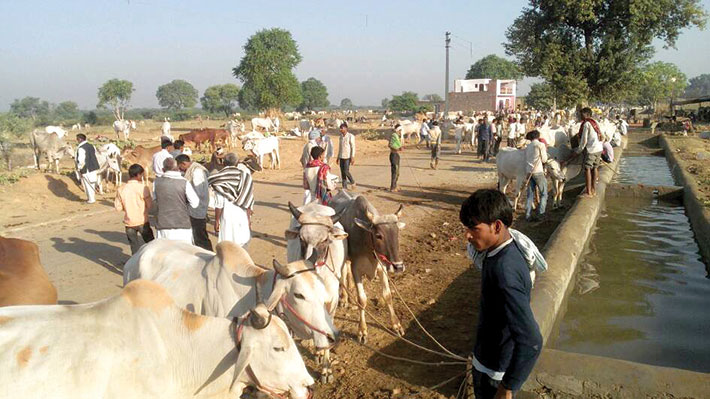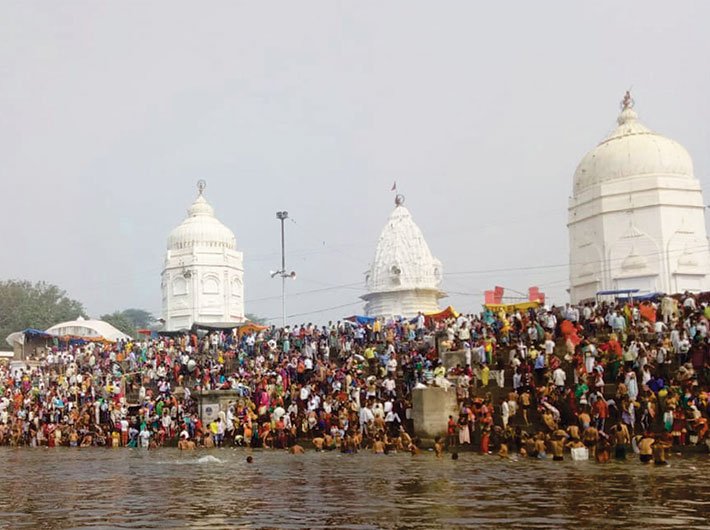On August 16, when the country lost its beloved former prime minister Atal Bihari Vajpayee, a nondescript village, 70 km from Agra, came into the limelight. Bateshwar, the ancestral village of Vajpayee, is situated along the notorious Chambal ravines on the banks of the Yamuna.
Vajpayee’s native village is a famous pilgrimage centre for Hindu and Jain communities. The leader spent over a decade of his childhood and early teenage in Bateshwar. The village also holds an important place in India’s history. The temple town has always been a place of action.
In ancient times, it was ruled by kings named in the Mahabharata. Thereafter, Nandas and Chandelas conquered it. It has seen wars led by Prithviraj Chauhan and the Mughals. In the 16th and 17th centuries, the village was the centre of several Maratha campaigns. The village has also made its contribution in India’s freedom struggle against the British rule.
The village is surrounded by forests and the Chambal river that connects three states: Uttar Pradesh, Madhya Pradesh and Rajasthan. This made Bateshwar an easy way out for the revolutionaries to escape from the British army during the pre-independence days.
“Bateshwar has a history of revolt against the British, starting from 1857. This village was under the stronghold of the Congress from 1927 to 1939. It witnessed much activity in 1942 during Mahatma Gandhi’s ‘Do or Die’ call. At that time, the British were arresting freedom fighters and activists from various towns and cities across the country. These arrests ignited strong rebel sentiments in people, especially the youth. Atal Bihari Vajpayee and his siblings were students at that time; and were influenced by the movement. It was from here that Vajpayee started fighting for the country,” says RV Smith, a Delhi-based historiographer.
As per some media reports, Vajpayee was arrested by the then British police for participating in ‘some’ revolutionary movement. The villagers claim that the leader and his aides were arrested for burning a police post in Bateshwar in 1942.
In the same year, the British thrashed many villagers for staging protests against their rule. The place where the police action took place is known as Gandhi Chabutara and has a big black stone with Gandhi’s ‘Quit India’ pledge carved on it.
“Vajpayee was acquitted later. But that case haunted him for a long time as it is said that one of his relatives was arrested after he named people who participated in the protest at that time,” says Rajesh Pal, a resident of Bateshwar, who lives barely a few metres away from the Gandhi Chabutara, where villagers now tie their goats and buffaloes.
Did you know?
- Bateshwar is a renowned religious centre both for Hindu and Jain communities.
- In the epic Mahabharat, Bateshwar is referred as Shouripur, a city of king Suresaine
- It is known for 101 Shivs temples built by Raja Badan Singh Bhadauria on a dam on the banks of Yamuna
- Shouripur, near Bateshwar, is said to be the birthplace of the 22nd Tirthankar of Jain faith, Lord Neminath
- The village is also known as the capital of king Vasudev, lord Krishna’s father
- Bateshwar mela is second largest animal fair in the country (Sonepur in Bihar being the largest)
“The board is hardly readable [now]. No one is even aware of this spot [Gandhi Chabutara]. We are simply utilising it,” Pal says laughingly, while asking his daughter to take the goats inside.
While most houses in Bateshwar are ‘pucca’, some were built over 150 years ago during the Mughal and British rule. Vajpayee’s house is one of the oldest establishments in the village, which is lying in a dilapidated state.
“No one has visited his house since decades,” says Ashish Parihar, who claims to be a journalist with a local Hindi daily.
It is also said that Bateshwar is one of the reasons for Vajpayee’s fondness of food. Along with non-vegetarian dishes, local delicacies like Behadahi Kachori, Andarse and Ghewar were his favourites, says Smith.
Mythology
Apart from being associated with a renowned leader like Vajpayee, the village of Bateshwar also boasts of ancient mythological significance.
Over 100 white-coloured Shiva temples stand in a straight queue attracts devotees into the village.
Explains the 56-year-old caretaker of the Bateshwar temple, Rakesh Bajpai: “Vasudev was the son of Shurasena who owned Bateshwar. Vasudev became the chief, after the death of his father. Vasudev’s wedding procession, which included horses, camels, elephants and bulls, travelled more than 150 kilometres to reach Mathura to his bride Devki (Krishna’s biological mother). Sadly, the procession couldn’t come back with the bride.”
Later, lord Krishna also spent some time in Bateshwar after killing his maternal uncle Kans and before proceeding towards Dwarka, he adds.
In that case, shouldn’t the place have temples of Krishna and not Shiva?
Bajpai shares another story.
“Centuries ago, kings of Bhadawar and Mainpuri were enemies. Once when the king of Bhadawar accidently entered Mainpuri, while hunting a lion, he was captured by the Mainpuri soldiers. A wise brahmin and a minister of Bhadawar dynasty suggested that both the parties must settle their feud to save themselves from outside invaders. The kings then decided to marry off their yet to be born kids,” says Bajpai.
Unfortunately, the queens of both the kingdoms gave birth to girls, but the king of Bhadawar announced that a son was born to him. On a pre-planned wedding date, Bhadawar’s daughter, dressed as a young man, was sent to wed the daughter of the Mainpuri chief. Feeling embarrassed on getting married to a girl, the princess of Bhadawar jumped into Yamuna with the idol of Lord Shiva whom she worshipped. It is said that the lord emerged from the river with the girl, changing her into a boy.
“Bhagwan Shiva ne unka badan parivartan kar dia, isliye unka naya naam pada Maharaja Badan Singh (Lord Shiva changed her body, hence he was named Maharaja Badan Singh),” says Bajpai. Badan Singh then married the princess of Mainpuri and constructed over 100 Shiva temples, which are now known as Bateshwar Mahadev.
These Shiva temples, all aligned with the Yamuna, are built in various shapes, styles and sizes. Some domes look like Islamic structures, while some depict typical Hindu style.
Raja Mahendra Aridaman Singh, the maharaja of Bhadawar dynasty since 1991, has another legend to share.
“I agree that one of my forefathers’ name was Maharaja Badan Singh who constructed these temples... Once Raja Badan Singh went to Jahangir’s durbar and was questioned which side the Yamuna flows. Badan Singh answered to the best of his knowledge, but when he came back he realised that he gave the wrong answer. Feeling embarrassed, he decided to build a dam on the river to change its direction. By the time he went to durbar again, his answer turned out to be true,” says Raja Mahendra Aridaman Singh.
Raja Aridaman Singh is a BJP leader and six times MLA from the Bah constituency. His wife Rani Pakshalika Singh is the current MLA from Bah. He further says that Jains believe Bateshwar is the birthplace of lord Neminath – the 22nd Jain tirthankar. As a result the village has multiple Jain temples too.
Legends apart, historians believe the Bateshwar group of temples were built in the post-Gupta era, the oldest ones probably dating from the 8th and 9th centuries. The Gurjara Pratiharas, who ruled a large swathe in northwestern India, are believed to have built them.
Notorious for its dacoits
The village which is steeped in ancient glory bears a deserted look today; the reason: its proximity to the Chambal valley and the dacoits. The rise in crime in the area, especially after independence till the late 1980s, forced people to move away. As a result just 800 people live in the village, which has an area of around 12.76 sq km. Almost 46 percent of the total area of the village is covered by forests.
“While one side of the village is surrounded by houses, both permanent and kutcha ones, the other side consists of grounds which almost every year gets submerged by the Yamuna and even Chambal, paving way for tall shrubs and bushes which is a good hiding spot for dacoits,” says Balwant Singh Tomar, nephew of Paan Singh Tomar – an Indian soldier and athlete-turned dacoit.

“Shayad yaha ke pani me hi kuch hai, jo peeta hai uska bhay nikal jata hai (perhaps there is something in the water of this place, whoever drinks becomes strong and fearless),” he adds.
Balwant too was a dacoit like Paan Singh, but he surrendered over two decades ago in Gwalior. Sharing his uncle’s firm faith in Bateshwar Nath, he says, “We used to walk along the circular embankment where there are many temples. A big copper bell hangs there.
“My uncle often used to offer water to lord Shiva at Bateshwar. There is a tradition among baghees to offer bells at the temple. I am not sure if Paan Singh did that.”
Bateshwar cattle fair
The village also serves as a big trade centre for cattle. Every year, around Diwali, a fair is organised in which thousands of animals like cows, bulls, oxen, camels, horses, goats and donkeys are sold. The Zila Parishad of Agra touts the cattle fair as one of the oldest in India.
The month-long fair is one of the prime sources of income of over 200 villages in the nearby areas, in UP, MP and Rajasthan.
“The fair is the only time when I earn the most. I use this money for the rest of the year,” says Kamlesh Bhadauriya, 57, resident of Bateshwar, who has been taking part in the cattle fair since he was four.

The annual cattle fair in Bateshwar
Explaining the motive behind these fairs, Raja Aridaman Singh says that his ancestors started organising the cattle fair to ensure people live in Bateshwar and take care of the temples. “The government needs people so that they can take care of the temples. Such fairs ensure that the population is earning well. In the medieval times, livestock traders used to come from as far as Kabul and Kandahar. Participation of both humans and animals used to be in millions. Even today, the fair is visited by over 10 lakh cattle traders and buyers from across India,” he says.
The neglected village
The fate of the village, however, looks rather gloomy. Neither its association with Vajpayee nor the ancient history or the biggest cattle fair could change its fortune.
Sumit Kumar Singh, a farmer from Bateshwar, complaints of frequent power cuts and lack of medical facilities and other basic infrastructure.
The only community healthcare centre (CHC) in Bateshwar, which was established with the efforts of Atal Bihari Vajpayee, hardly has any doctors. In fact in early September, a ruckus was created by the relatives of a woman who died allegedly due to lack of immediate medical treatment. The Bah tehsil has some private hospitals, which obviously come with a price tag.
The village roads are also in a bad condition. The roads, especially the roller compacted concrete (RCC) ones, which were built after the initiative of Raja Aridaman Singh, doesn’t exist anymore, says Parihar.
“Only roads near the village are in good shape; those inside the village are in a bad shape. There are no drains on the sides of the roads, so rains have damaged them badly. The silt, which was spread over the RCC roads, has turned it into a muddy terrain. Hence, it is difficult to even walk on them, forget driving,” adds Parihar.
Most people in Bateshwar are engaged in farming, the rest work as labourers, either in farms or at construction sites. Interestingly, the village, with just two government schools till class VIII, has managed to maintain one of the highest literacy rates in Uttar Pradesh.
With the nearest railway station four kilometres away, the residents of Bateshwar depend on buses to travel to nearby places. The residents, however, allege that hardly any buses come at the stand.
Sumit Kumar Singh claims that the district administration installed lights in the village before UP CM Yogi Adityanath’s visit, but as soon as the CM left the administration removed all the lights installed. Even the cement and bricks, which were brought to the village for the construction of roads ahead of CM’s visit, were sent back, he says.
“There was no electricity in the village for five days before Vajpayeeji’s mortal remains were immersed in the Yamuna here. Even the sale of cattle is declining; people use machines for most tasks. People may come and go, but this village is only surviving with the blessings of Bateshwar Nath,” says Parihar.
feedback@governancenow.com
(The article appears in the September 30, 2018 issue)

